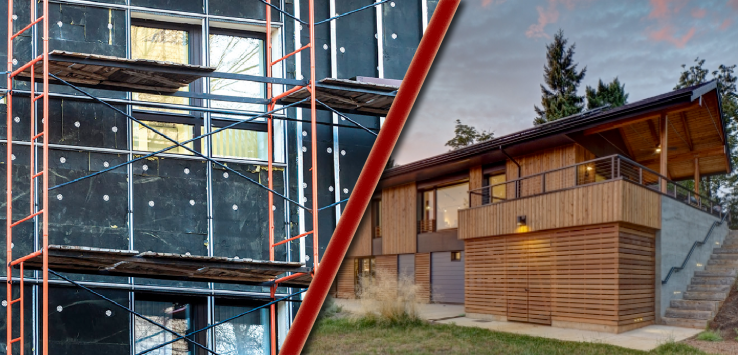Buildings in the United States consume about 40% of all energy and 75% of all electricity. Attempts to decarbonize our economy necessarily run through buildings. However, we have limited resources and what to prioritize is not always obvious. We could try to retrofit existing, inefficient homes. Or we could focus on new construction that is built efficient from the ground up. To explore this issue further, I recently moderated a debate on the following resolution:
When the two come into conflict, the federal government ought to prioritize resources for retrofit programs over new construction programs.
While debaters on both sides of the resolution agreed on the importance of improving the energy efficiency of both existing and new buildings, the competition of ideas led to a lively discussion about our nation’s research priorities and relationship with industry. The question is, undoubtedly, a complicated and multifaceted one. Therefore, we invited a representative from each side to share abridged versions of their arguments. Rhett will advocate for retrofits, and Newton for new construction.
If we could only choose one, should we focus on retrofit programs or new construction programs?
| Rhett: | The answer is retrofits. There are 118 million existing homes in the U.S., plus another 5-6 million commercial buildings. Over half those buildings are at least 40 years old, and they are generally very inefficient. You can save 20-30% of energy usage through simple interventions, and well beyond 50% if you improve the envelope. They represent a significantly larger opportunity for energy savings. |
| Newton: | I hate to disagree, but the answer is new construction. We acknowledge that there are many, many more existing buildings than new buildings. However, there are about 1 million new homes built each year. And 33% of all existing homes in 2060 have yet to be built. If we do everything we can to make new construction more efficient, we will have addressed 33% of the entire market right there. |
But we’re talking 124 million existing buildings compared to only 1 million new buildings per year. The opportunity presented by retrofit programs seems pretty overwhelming, no?
| Newton: | It’s not just about the number of buildings. We have to consider which type of buildings we can most effectively impact. Getting energy efficiency into new construction is far easier than existing homes. |
| Rhett: | I agree that getting into existing homes is more difficult, but that doesn’t diminish the opportunity. Much more funding is still put into remodeling and simple energy equipment replacements each year, and we can build on that. |
| Newton: | But the real question is where will those solutions come from? Where will they be developed, honed, and readied for the existing home market? That is much more challenging, and I would submit that all the innovations that spill into the retrofit market are coming from progress in new construction. |
Why do you think the majority of innovations are being developed in new construction?
| Newton: | There are two reasons. The first is customer demand. New efficient buildings have energy bills that are a fraction of those in existing. They are also 2-3 times more comfortable and provide greater health benefits. Once people experience that contrast, it drives demand. The second is economies of scale. It’s easier to get innovations into new construction, so this is what drives the market for energy efficient technologies. Afterwards they work their way downstream into the retrofit market. |
| Rhett: | Except we generally still see insufficient innovation in new construction. The sector has so many actors like architects, builders, manufacturers and others, and they are just not well-integrated. Where there is room for improvement – and where we are further ahead right now in other industries – is automation and prefabrication. This can be done either on-site or off-site. These innovations haven’t taken off in new construction, and we shouldn’t have to wait until they do. |
| Newton: | I couldn’t agree more about the benefits of automation, but let’s look at a great example of where it works. In Sweden 85% of new homes are constructed off-site. This market helped improve the plans, machinery, digitized technology, and automation expertise that makes their new construction so effective. This automation infrastructure then transferred to retrofits through a program called Energiesprong, which is now a world influencer in the mass improvement of existing homes. But it wouldn’t be where it is if not for new construction. |
How do health and equity fit in?
| Rhett: | It’s incumbent on the government to make sure these retrofit opportunities are available to everyone and easy to install at a reasonable cost. A greater percentage of the older, draftier homes have higher energy bills and, unfortunately, are occupied by individuals with lower incomes who don’t always have the ability to pay for improvements. Or they might be in a tenant-based situation where the owner is just not paying for them. |
| Newton: | I fully agree on that. I’m just making a point that the solutions to achieve better health and equity will exist because the new home market enables the scale and the technology development. Then, the improvements you need are there faster than if you started with existing homes. |
| Rhett: | But there’s an immediacy to this issue. If you only focus on new construction, you’re going to have either really high energy bills or you’re going to have people who are really suffering because they can’t afford to turn on their heat or their air conditioning. It’s on the government to come up with ideas and options that are there for everyone and not just for those who can afford a new home. |
| Newton: | I don’t disagree with any of that. It’s only when they come into conflict and you have to make choices that you should opt for the infrastructure, the skills, and the installation expertise that you’ll get in the new home industry and then you can translate it over to existing buildings. |
Where can the federal government have the greater impact?
| Newton: | To echo a point Rhett made earlier, we have about 100,000 contractors in the U.S. who work on new and existing buildings. That level of fragmentation makes it impossible to innovate and develop new solutions for industry. We have found that publicly-owned builders only invest less than 0.1% in innovation R&D, as compared to 4% for non-agricultural corporations. The only way we get innovation is through high-performance product manufacturers. The Department of Energy’s Building America program fills a huge gap in developing innovations, validating them in the field, and building consumer interest. Given the absence of investment in a fragmented industry, what we do in our nation’s new construction programs is vitally important. |
| Rhett: | As Newton alluded to, industry does to some degree put money into product manufacturing because they want to continue to sell upscale versions of their technologies. But very few, if any, are putting money into tackling existing buildings in a wholesale manner. Right now cities are dealing with energy, environmental, and equity challenges. They realize they need to address problems in buildings that people are currently living and working in. The federal government is in a unique position to aggregate the interest in this area. It can push academia, the national labs, and industry to focus their ingenuity into retrofits. Together they can help retrofits be quick, attractive, easy to deploy, and affordable. That’s just not something that will happen on its own. |





Leave a Reply